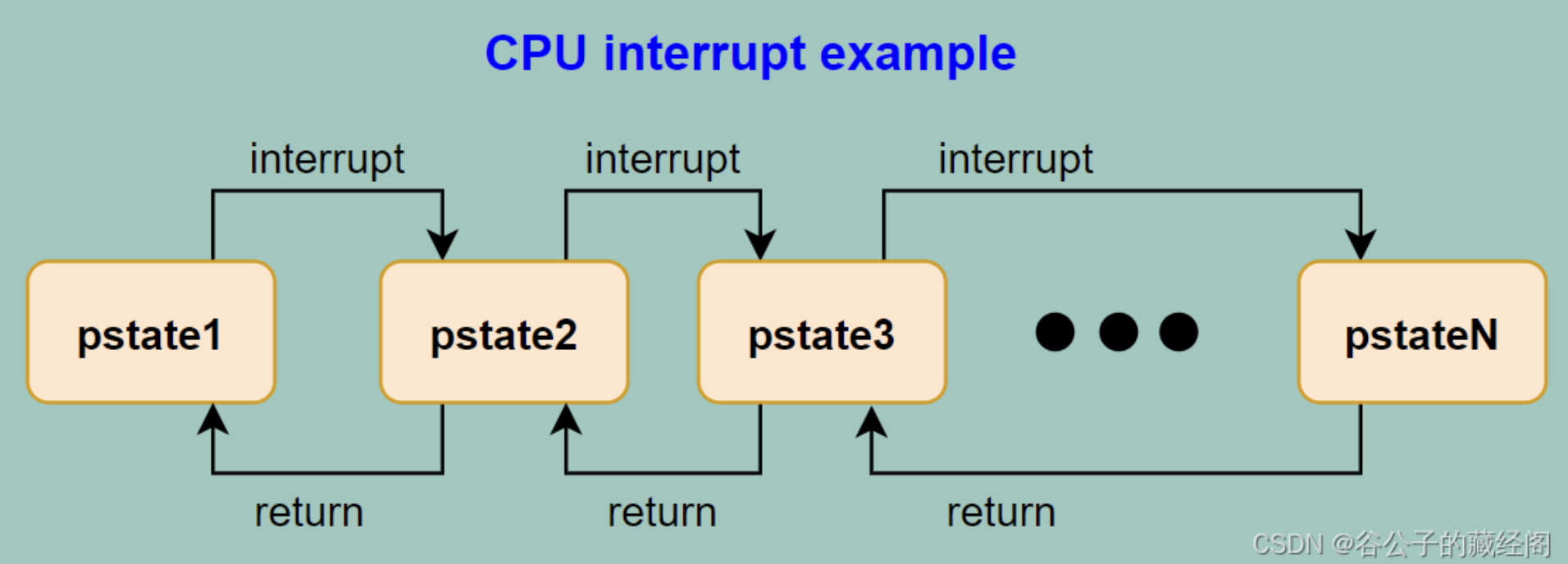1. 前言
软件设计模式定义了一组类和它们之间的关系,它们相互作用用以解决软件开发过程中面临的常见问题。由于验证工程师所做工作的重要部分包括使用面向对象语言(如SystemVerilog)进行编码,因此许多遇到的挑战都适合应用特定的设计模式来解决。将它们应用到代码中,有助于代码的可重用性和可维护性,从而提高了整体代码质量。本文介绍备忘录(亦称: 快照、Snapshot、Memento)在验证环境中的使用,来对设计逻辑中实现的特性进行建模。
2. 备忘录
备忘录模式是一种行为设计模式, 允许在不暴露对象实现细节的情况下保存和恢复对象之前的状态。在软件开发环境中,它在应用程序中提供了撤销机制,促进了数据的隐藏,并且不违背封装原则。在验证环境中,它可以用来对需要“恢复的场景”进行建模。举个例子,如下图所示,比如Arm CPU运行在状态pstate1下,这时候突然来了个中断导致它切换到状态pstate2,中断可能嵌套,继续切换到状态pstate3、pstate4、pstate5等等,中断处理结束后,需要返回到之前的运行状态。因此在中断切换状态时需要保存当前的CPU状态信息,这样才能在中断处理完成后,根据历史保存的CPU状态信息切换回来。备忘录模式提供了很好的建模方式。
备忘录模式提供了三个主要组件:
Memento:表示要保存和恢复的内容的容器类,在上图示例中Memento类包含pstate的状态和相应的get/set方法。
Originator:使用Memento类来保存当前的状态。它类似于这里CPU的角色。
Caretaker:请求Originator保存状态,且它直到所有保存的状态,并且可以请求恢复到历史的某个状态。
下图使用UML类图提供了上述三者之间的图形化关系,如何看懂UML类图大家可以自行搜索下资料。
3. 参考代码
CPU处理中断进入和返回状态的参考代码如下:
typedef struct packed {
bit [3:0] nzcv;
bit [1:0] currentel;
bit tco;
} pstate_t;
class memento extends uvm_object;
`uvm_object_utils (memento)
local pstate_t pstate;
function new (string name = "memento");
super.new(name);
endfunction : new
function void set_pstate(pstate_t _pstate);
this.pstate = _pstate;
endfunction : set_pstate
function pstate_t get_pstate();
return pstate;
endfunction : get_pstate
endclass : memento
class originator extends uvm_object;
`uvm_object_utils (originator)
local pstate_t pstate;
function new (string name = "originator");
super.new(name);
endfunction : new
function void change();
pstate = $random();
endfunction : change
function memento create_snapshot();
memento m_memento = memento::type_id::create("m_memento");
m_memento.set_pstate(pstate);
`uvm_info("[snapshot pstate:]", $psprintf("nzcv:'b%b, currentel:'b%b, tco:'b%b", pstate.nzcv, pstate.currentel, pstate.tco), UVM_LOW)
return m_memento;
endfunction
function void restore (memento _snapshot);
pstate = _snapshot.get_pstate();
`uvm_info("[restore pstate:]", $psprintf("nzcv:'b%b, currentel:'b%b, tco:'b%b", pstate.nzcv, pstate.currentel, pstate.tco), UVM_LOW)
endfunction : restore
endclass : originator
class caretaker extends uvm_object;
`uvm_object_utils (caretaker)
local memento memento_q[$];
local originator m_orig;
function new (string name = "caretaker");
super.new(name);
endfunction : new
function void set_originator(originator _m_orig);
m_orig = _m_orig;
endfunction : set_originator
function void dosomething();
memento_q.push_back(m_orig.create_snapshot);
m_orig.change();
endfunction : dosomething
function void undo(int unsigned _index);
if (_index > memento_q.size() || memento_q.size() == 0 ) $fatal;
m_orig.restore(memento_q[_index]);
endfunction : undo
endclass : caretaker模拟测试代码如下:
class monitor;
function void test();
caretaker m_caretaker = caretaker::type_id::create("m_caretaker");
originator m_originator = originator::type_id::create("m_originator");
m_caretaker.set_originator(m_originator);
m_caretaker.dosomething(); // snapshot0
m_caretaker.dosomething(); // snapshot1
m_caretaker.dosomething(); // snapshot2
m_caretaker.dosomething(); // snapshot3
m_caretaker.undo(1);
m_caretaker.dosomething(); // snapshot4
m_caretaker.undo(3);
endfunction : test
endclass : monitor输出仿真结果如下:
[[snapshot pstate:]] nzcv:'b0000, currentel:'b00, tco:'b0
[[snapshot pstate:]] nzcv:'b0100, currentel:'b10, tco:'b0
[[snapshot pstate:]] nzcv:'b0000, currentel:'b00, tco:'b1
[[snapshot pstate:]] nzcv:'b0001, currentel:'b00, tco:'b1
[[restore pstate:]] nzcv:'b0100, currentel:'b10, tco:'b0
[[snapshot pstate:]] nzcv:'b0100, currentel:'b10, tco:'b0
[[restore pstate:]] nzcv:'b0001, currentel:'b00, tco:'b1在提供的示例中,保存和恢复动作是由中断进入和中断退出事件触发的。在UVM中,事件由监视器(monitor)发出的,该监视器观察中断接口并使用Memento设计模式。该例子支持保存和恢复多个CPU状态。遇到中断时,caretaker的do_something()函数在开始时就把当前的pstate存储到memento里,然后进行其它的中断处理动作,相当于备份了历史状态。如果中断结束了,caretaker的undo()函数可以指定返回到哪个历史状态。
下次给大家分享下设计模式中责任链模式(Chain of Responsibility)在芯片验证中的应用。
作者:谷公子
文章来源:CSDN
推荐阅读
更多IC设计干货请关注IC设计专栏。
迎添加极术小姐姐微信(id:aijishu20)加入技术交流群,请备注研究方向。




